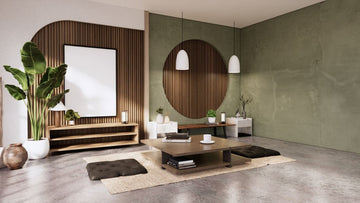What is Japandi Interior Design? Achieving the Style on a Budget
by Khent Barangas on Oct 30, 2025

If you spend time on Pinterest for home inspiration, you have likely noticed a popular interior style appearing again and again. Clean lines, neutral tones, and cozy details—it seems to be everywhere. And yes, it has a name. It’s the popular Japandi interior style.
This is a mix of Japanese minimalism and Scandinavian coziness. It is calm, balanced, and easy on the eyes, perfect for small condos and compact living spaces.
No wonder the Japandi style is gaining so much attention. This design approach has been around for ages, yet it continues to stay trendy today.
The good news? You can achieve it without overspending.
In this guide, we’ll explore what makes Japandi design unique and why it works so well in Filipino homes. Plus, you’ll get practical Japandi budget tips to recreate this aesthetic affordably.
What is Japandi Interior Style?

Japandi interior style is the harmonious fusion of Japanese minimalism and Scandinavian warmth. It is a design philosophy that emphasizes simplicity, functionality, and comfort, creating spaces that feel calm, balanced, and purposeful.
The origins of Japandi go back hundreds of years. When Japan opened its borders in the mid-1800s after 200 years of isolation, Scandinavian designers and artists visited the country and were fascinated by its style, culture, and craftsmanship. They brought back inspiration, which influenced Scandinavian design and set the stage for Japandi.
This partnership worked so well because Japanese and Scandinavian design share many similarities. Both value simplicity, natural materials, high-quality craftsmanship, and functional beauty. That common ground made it easy for the two styles to merge, creating spaces that are minimalist yet warm, and functional yet cozy.
Japandi style also draws its inspiration from two major design philosophies. From Japan comes wabi-sabi, which celebrates imperfection, natural materials, and the beauty of simplicity. From Scandinavia comes hygge, which emphasizes coziness, warmth, and comfort in everyday life.
By combining these two approaches, Japandi achieves the perfect balance: minimalist yet warm, functional yet cozy, and visually calming while full of personality.
4 Key Elements of Japandi Design

To achieve the Japandi interior style, it helps to know its key elements. These are the characteristics that define the look and feel of Japandi spaces:
1. Clean Lines and Minimalism
Japandi emphasizes simplicity. Furniture and décor feature clean, straight lines without unnecessary ornamentation. This minimalism helps create airy, uncluttered spaces that feel calm and organized.
2. Neutral Color Palettes
The Japandi color palette is entirely rooted in nature. Colors in Japandi design are soft and muted, such as beige, taupe, soft gray, off-white, and earthy tones.
3. Natural Materials
Wood, bamboo, rattan, linen, and stone are commonly used in Japandi interiors. These materials add texture, warmth, and a connection to nature. Using natural materials not only enhances aesthetics but also supports a sustainable approach to home design.
4. Natural Light
Light is treated as a design element in Japandi. Large windows, sheer curtains, and open layouts are used to let natural light fill the room. The result is a bright yet soft ambiance that enhances the minimalist and cozy balance of this style.
How to Achieve a Japandi Look on a Budget
You do not need to spend a fortune to bring the Japandi interior style into your home. With a few smart choices, you can capture its clean and cozy look without overspending. Here are practical tips you can try.
1. Start with Decluttering
Japandi is all about minimalism. Before buying anything new, clear out items you no longer use or that do not serve a purpose. This instantly gives your space a calm and organized feel.
2. Use Affordable Neutrals

Repainting is one of the most budget-friendly ways to refresh your space. Stick to neutral shades like beige, cream, or soft gray. These colors set the foundation for a Japandi vibe.
You can also try limewash paint for a natural, textured effect. Limewash has an earthy, organic look that fits Japandi aesthetics and can often be DIYed at a lower cost than wallpaper or high-end finishes.
3. Incorporate Natural Textures
You don’t need expensive furniture to achieve the look. Add natural materials through affordable finds like rattan baskets, bamboo trays, or linen pillow covers. Local markets and home stores often carry these pieces at a fraction of the cost.
4. Add Greenery

Plants are a simple, inexpensive way to achieve the “indoor-outdoor” balance that Japandi embraces. A few well-placed indoor plants, even common ones like snake plants or pothos, instantly soften minimalist interiors.
Repurpose ceramic bowls or clay pots as planters to stay within budget while keeping the look natural.
5. Maximize Natural Light
Japandi style emphasizes openness and airiness. The cheapest way to achieve this is by maximizing natural light. Replace heavy curtains with sheer ones or remove them altogether if privacy allows. If windows are limited, use mirrors to reflect light and make your space feel brighter and more spacious.
6. Mix Soft and Hard Textures
Japandi is all about balance. Pair natural wood furniture with soft linen or cotton fabrics. Add bouclé cushions, woven rugs, lampshades, or a candle warmer to bring warmth to clean-lined furniture. This creates coziness without overspending on high-end Décor.
7. Shop for Vintage or Pre-Loved Pieces

Japandi values sustainability and craftsmanship, which makes secondhand shopping a perfect fit. Look for vintage wood furniture, clay pots, or ceramic accents in thrift shops or online marketplaces. Not only are they more affordable, but they also add a timeless character to your space.
8. Use Pegboards for Functional Storage
Pegboards are an affordable and minimalist way to add storage without clutter. You can mount one in the kitchen for utensils, in the entryway for bags and hats, or even in a study nook for supplies.
To keep the Japandi vibe, go for wood-toned or neutral-colored boards. A good option is the Cre8tivity wooden pegboard, which blends functionality with natural aesthetics.
9. Highlight Architectural Details

Instead of adding more furniture or decor, pay attention to what your space already offers. A simple archway, wooden beam, or natural-textured wall can become a design feature. Emphasize it with good lighting or keep the area uncluttered so the detail stands out.
10. Buy Functional, Multipurpose Furniture
Look for pieces that combine function and style. For example, a sofa bed is perfect for small condos since it works as both seating and an extra bed for guests. Or a simple wooden bench can double as seating and shelving. These types of furniture embody Japandi’s practical and space-saving design.
Japandi-Inspired Decor to Try at Home

To help you design your home with a Japandi style, here are some key décor pieces you can add to your space:
- Wooden trays or stools
- Stone bowls or candle holders
- Paper lanterns or shoji-inspired lamps
- Cotton or linen throws
- Rattan baskets or chairs
- Neutral-toned pillow covers
- Ceramic teapots and cups
- Minimalist vases
- Books as intentional décor
- Sheer curtains or rice-paper blinds
Quality Over Quantity
At its core, Japandi is about quality over quantity, choosing fewer but better pieces that bring balance, warmth, and intention into your home.
Ready to bring Japandi into your own space? Browse our collection of furniture to find Japandi-inspired pieces that reflect your style. Visit our official store on Lazada, Shopee, and TikTok to get exclusive promotions.








